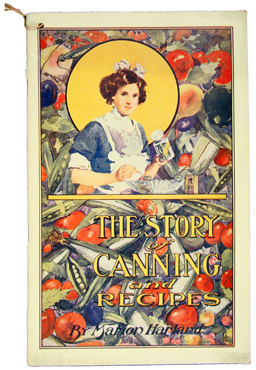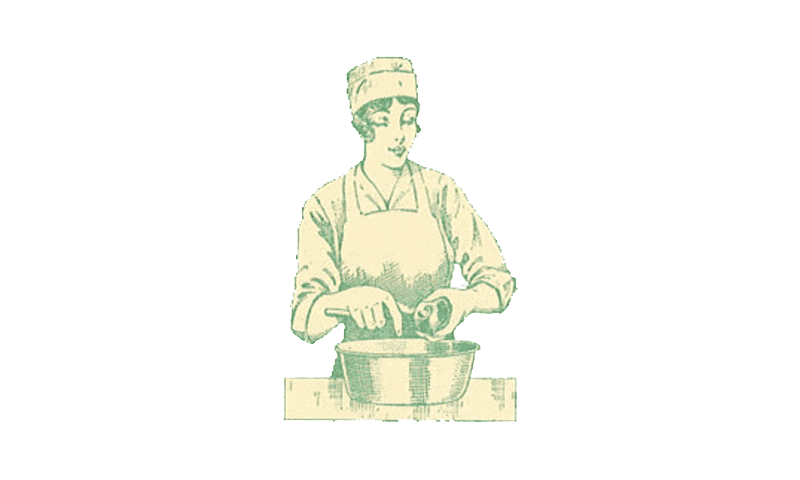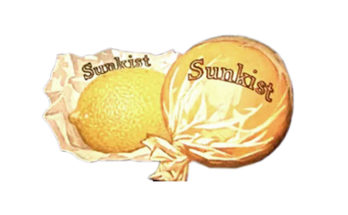1910: The Story of Canning and Recipes
Marion Harland
The Story of the Canning Industry.
…for a long line of centuries, mankind knew but two methods…Desiccation and Salt….the sons of Ishmael dried the yield of the date palm, subjected it to powerful pressure, and packed it into bags for the daily food of caravans toiling over trackless wastes of sand where no vegetation ever struck root….tribes of Tartary and their rations of dried horseflesh….Northern nomads with their winter diet of parched maize and jerked buffalo meat….
Within my own recollection, and after the magnetic telegraph had circled the earth, and steam-ships were making the far isles of the sea our neighbors, housewife and agriculturist held steadily to Salt and Desiccation…We stewed down fruits in sugar… We dried apples, beans, peas, corn and tomatoes in the sun…. we hit upon the expedient of salting down green corn, then shutting out the air by pouring lard upon the surface….
…offer of the French government in 1795 of a prize…for the practical method of preserving Food….Yet it was fourteen years before any record of a successful attempt to solve the mighty problem was recorded….Nicholas Appert signed a receipt for the prize money….Yet, forty years thereafter, we find scientific men shaking doubtful heads over the claims of daring adventurers into the realm of practical demonstration for an indefinite period by subjecting them to intense and continued heat and sealing them up in boiling hot air-tight cans. The infant and audacious industry dealt for several years with tomatoes and peaches only. We paid gladly fifty cents for a quart-can of tomatoes, and a dollar for the same quantity of peaches….This was in 1857.
…let me enjoin upon the cook who uses the recipes…to an inflexible law in the management of canned foods. Never turn the contents of a newly-opened can directly into the vessel in which they are to be cooked. If I have not prefaced each recipe by this injunction, it is from fear of tediousness in the repetition. — Marion Harland
Salmon Cutlets
Drain canned salmon and flake to a smooth mass, adding a raw egg, well-beaten, a handful of dry crumbs, a pinch of mace, a dash of paprica, and a cupful of white sauce. Mix well, and set aside to stiffen. Form, when stiff, into cutlet-shapes, dip in egg and cracker-dust, and set on the ice for an hour before frying in deep fat. A piece of raw macaroni may be stuck into each cutlet to simulate the rib on a French chop.
Baked Spinach
Drain canned spinach and chop very fine. Into this chopped mass beat four beaten eggs, a tablespoonful of flour stirred into a cup of cream, salt and pepper to season, and a tablespoonful of melted butter. Beat long and hard, turn immediately into a greased baking dish, and set in the oven. Bake to a light brown and serve as soon as done.
Pineapple Pie
Put canned pineapple, drained from its liquor, through the meat-chopper. Beat the yolks of two eggs, add to them a teaspoonful of butter rubbed smooth with a cup of sugar, stir in a cup of milk and beat in the minced pineapple. Pour immediately into an open crust and bake in a moderate oven. When done, spread with a meringue made by beating the white of an egg stiff with a tablespoonful of powdered sugar. Return to the oven long enough to brown lightly.
Chili Sauce
Drain the liquor from canned tomatoes, and measure the drained vegetable. To two quarts of tomatoes allow a pint of onions,–the small, white ones, chopped,–a teacupful of brown sugar, four tablespoonfuls, each, of powdered cloves, allspice and cinnamon, a heaping teaspoonful of ground ginger, and a saltspoonful of cayenne pepper. Put the spices into the vinegar, and when hot, add the other vegetables and cook, steadily, for two hours. Set aside until cold, bottle and seal.
40-pages.



